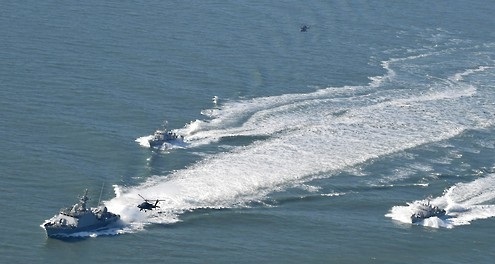South Korea and the US will employ an operational guideline to counter North Korea’s nuclear and missile facilities including the use of Washington’s advanced missile defense system for the first time during their upcoming annual joint military exercises, Seoul’s military officials said Wednesday.
During the Key Resolve computer-simulated drills scheduled to kick off in March, the allies will apply the principles of “4D” -- detect, defense, disrupt and destroy. Adopted in 2015, the concept is a centerpiece of their defense strategy to deal with a missile attack from Pyongyang.
The annual exercise will also simulate a scenario where the allies will use the Terminal High Altitude Area Defense battery at an initial phase of the exercise program to intercept incoming North Korean ballistic missiles.
During the Key Resolve computer-simulated drills scheduled to kick off in March, the allies will apply the principles of “4D” -- detect, defense, disrupt and destroy. Adopted in 2015, the concept is a centerpiece of their defense strategy to deal with a missile attack from Pyongyang.
The annual exercise will also simulate a scenario where the allies will use the Terminal High Altitude Area Defense battery at an initial phase of the exercise program to intercept incoming North Korean ballistic missiles.

“I understand the 2017 Key Resolve drill will include a new scenario where (South Korea and the US) will use THAAD’s defensive assets to prevent North Korea’s ballistic missiles,” said a government official who declined to be identified.
Seoul’s Defense Ministry said they have yet to finalize the scenario, adding that they are still working on the specifics with the Combined Forces Command, which had previously taken the lead in the exercise but will hand it over to South Korea’s Joint Chiefs of Staff this year.
The forthcoming drill is expected to be the biggest-ever in scale, with the allies in consultation over a permanent stationing of US strategic assets on the peninsula. A week earlier, Gen. Lee Sun-jin, the chairman of South Korea’s Joint Chiefs of Staff, reiterated the request to his counterpart Gen. Joseph Dunford.
During his first overseas trip as the new US defense secretary, Jim Mattis and his counterpart Han Min-koo vowed to push ahead with the THAAD deployment this year as planned. A THAAD battery is expected to be deployed as early as this summer on a golf course in Seongju, North Gyeongsang Province.
In their annual Security Consultative Meeting in late 2015, South Korea and the US adopted the “4D” concept as an operational guideline to counter nuclear and missile threats from North Korean, which has recently threatened to launch an intercontinental ballistic missile “at any time and place.”
The allies applied the concept for the first time during last year‘s exercise. In the latest edition, they are expected to focus on fleshing it out into a more sophisticated one, the military officials said.
The 4D stands for “Detect, Defense, Disrupt, Destroy.” “Detect” represents the allies’ procedures to track North Korea’s missile movements with various intelligence-gathering assets, while “Defense” refers to a set of allied defensive operations to minimize any damage from potential attacks.
“Disrupt” means striking North Korea’s core missile facilities including supporting installations, while “Destroy” refers to the allies’ efforts to demolish the North’s mobile launchers and incoming missiles.
By Yeo Jun-suk (jasonyeo@heraldcorp.com)
Seoul’s Defense Ministry said they have yet to finalize the scenario, adding that they are still working on the specifics with the Combined Forces Command, which had previously taken the lead in the exercise but will hand it over to South Korea’s Joint Chiefs of Staff this year.
The forthcoming drill is expected to be the biggest-ever in scale, with the allies in consultation over a permanent stationing of US strategic assets on the peninsula. A week earlier, Gen. Lee Sun-jin, the chairman of South Korea’s Joint Chiefs of Staff, reiterated the request to his counterpart Gen. Joseph Dunford.
During his first overseas trip as the new US defense secretary, Jim Mattis and his counterpart Han Min-koo vowed to push ahead with the THAAD deployment this year as planned. A THAAD battery is expected to be deployed as early as this summer on a golf course in Seongju, North Gyeongsang Province.
In their annual Security Consultative Meeting in late 2015, South Korea and the US adopted the “4D” concept as an operational guideline to counter nuclear and missile threats from North Korean, which has recently threatened to launch an intercontinental ballistic missile “at any time and place.”
The allies applied the concept for the first time during last year‘s exercise. In the latest edition, they are expected to focus on fleshing it out into a more sophisticated one, the military officials said.
The 4D stands for “Detect, Defense, Disrupt, Destroy.” “Detect” represents the allies’ procedures to track North Korea’s missile movements with various intelligence-gathering assets, while “Defense” refers to a set of allied defensive operations to minimize any damage from potential attacks.
“Disrupt” means striking North Korea’s core missile facilities including supporting installations, while “Destroy” refers to the allies’ efforts to demolish the North’s mobile launchers and incoming missiles.
By Yeo Jun-suk (jasonyeo@heraldcorp.com)


![[AtoZ into Korean mind] Humor in Korea: Navigating the line between what's funny and not](http://res.heraldm.com/phpwas/restmb_idxmake.php?idx=644&simg=/content/image/2024/04/22/20240422050642_0.jpg&u=)
![[Exclusive] Korean military set to ban iPhones over 'security' concerns](http://res.heraldm.com/phpwas/restmb_idxmake.php?idx=644&simg=/content/image/2024/04/23/20240423050599_0.jpg&u=20240423183955)



![[Graphic News] 77% of young Koreans still financially dependent](http://res.heraldm.com/phpwas/restmb_idxmake.php?idx=644&simg=/content/image/2024/04/22/20240422050762_0.gif&u=)
![[Herald Interview] Why Toss invited hackers to penetrate its system](http://res.heraldm.com/phpwas/restmb_idxmake.php?idx=644&simg=/content/image/2024/04/22/20240422050569_0.jpg&u=20240422150649)





![[Exclusive] Korean military to ban iPhones over security issues](http://res.heraldm.com/phpwas/restmb_idxmake.php?idx=652&simg=/content/image/2024/04/23/20240423050599_0.jpg&u=20240423183955)



![[Today’s K-pop] Ateez confirms US tour details](http://res.heraldm.com/phpwas/restmb_idxmake.php?idx=642&simg=/content/image/2024/04/23/20240423050700_0.jpg&u=)